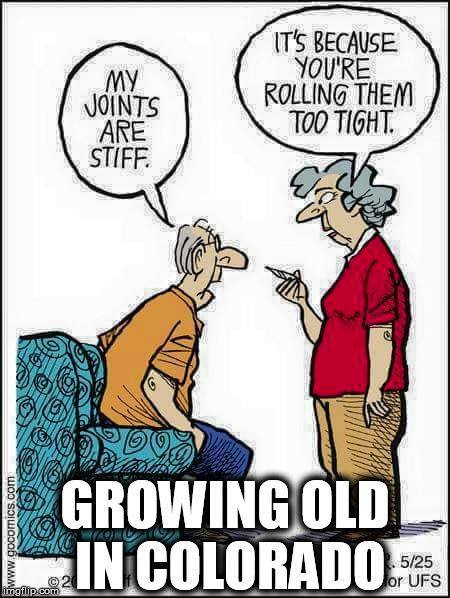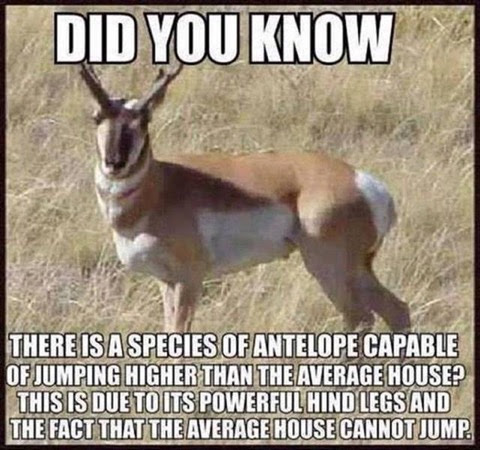You just know that some idiot will try this out even after being told to not do it, Right?
Category: Gear & Stuff
224 Weatherby Magnum




Now I am sure that this is a good round. But & it’s a BIG but! Like all Weatherby gear. What happens if you are out in the big beyond & the following happens?
You forget to bring enough ammo? I have done that!
Or God forbid! You have a malfunction & the local Gun Witch Doctor does not have the parts to fix it? Oops!
It kind a puts a crimp on your hard earned fun time doesn’t it? Something to think about huh?
Grumpy
224 Weatherby Magnum
| .224 Weatherby Magnum | ||||||||||||||||||||
|---|---|---|---|---|---|---|---|---|---|---|---|---|---|---|---|---|---|---|---|---|
| Type | Rifle | |||||||||||||||||||
| Place of origin | USA | |||||||||||||||||||
| Production history | ||||||||||||||||||||
| Designer | Roy Weatherby | |||||||||||||||||||
| Designed | 1963 | |||||||||||||||||||
| Specifications | ||||||||||||||||||||
| Parent case | None, proprietary | |||||||||||||||||||
| Case type | Belted, bottleneck | |||||||||||||||||||
| Bullet diameter | .224 in (5.7 mm) | |||||||||||||||||||
| Neck diameter | .252 in (6.4 mm) | |||||||||||||||||||
| Shoulder diameter | .394 in (10.0 mm) | |||||||||||||||||||
| Base diameter | .415 in (10.5 mm) | |||||||||||||||||||
| Rim diameter | .430 in (10.9 mm) | |||||||||||||||||||
| Case length | 1.923 in (48.8 mm) | |||||||||||||||||||
| Overall length | 2.330 in (59.2 mm) | |||||||||||||||||||
| Rifling twist | 1-12″ | |||||||||||||||||||
| Primer type | Large rifle | |||||||||||||||||||
| Ballistic performance | ||||||||||||||||||||
|
||||||||||||||||||||
| Test barrel length: 24″ Source(s): Hodgdon [1] |
||||||||||||||||||||
The .224 Weatherby Magnum (5.56×49mmB) is a sporting cartridge that was developed in 1963 by Roy Weatherby after about 10 years of development.[2]
It is a proprietary cartridge with no major firearms manufacturers chambering rifles for it other than Weatherby.
It was originally called the .224 Weatherby Varmintmaster when it was introduced alongside the Weatherby Varmintmaster rifle, but the rifle was discontinued in 1994 and the cartridge was renamed.
Design
The cartridge design began years earlier but its introduction was delayed, at least in part, because of the unavailability of a suitable action.
An earlier high-velocity .22 caliber round from Weatherby called the .220 Weatherby Rocket was based on the .220 Swift though it was unsuccessful and never manufactured.[3]
Performance
Performance is similar to the popular .22-250 and the lesser used .225 Winchester putting it in between the .220 Swift and .223 Remington cartridges.
Possibly because of the similar performance and popularity of the .22-250, this round has never gotten a very large following. Costs for ammunition and rifles for this round also tend to be much more expensive.
| Muzzle | 100 Yds | 200 Yds | 300 Yds | 400 Yds | 500 Yds | ||
|---|---|---|---|---|---|---|---|
| Trajectory | – | 2.8 | 3.7 | 0 | -9.8 | -27.9 | |
| Energy (ft·lbf) | 1627 | 1244 | 944 | 705 | 516 | 370 | |
| Velocity ([[Feet per second | ft/s]]) | 3650 | 3192 | 2780 | 2403 | 2056 | 1741 |
Sporting Use
.22 caliber rifles are legal in some areas for big game up to the size of deer or larger. Convention holds the .224 Weatherby and similar cartridges are better suited to long-range varminting.[4]
Similar statements are made concerning other “big” 22 caliber cartridges like the 220 Swift and .223 WSSM.
Currently many states in the United States do allow 22 caliber rifles on big game, but the majority require a minimum of 6mm.[5]
Well known firearms author P.O. Ackley believed that fast 22 caliber cartridges were suitable for medium-large game.[6] Craig Boddington has said that such cartridges are suitable for smaller deer.[5]
Bullets suited for hunting big-game are available from major manufacturers such as Nosler and Barnes.[7]
See also
- 5 mm caliber, other cartridges of 5–6 mm (.200–.236 in) caliber.
- List of rifle cartridges
- Table of handgun and rifle cartridges
References
- Jump up^ Hodgdon Online Reloading Data
- Jump up^ .224 Weatherby at the Reload Bench[self-published source]
- Jump up^ Cartridges of the World 8th Edition, Book by Frank C. Barnes, DBI Books, 1997, ISBN 0-87349-178-5 p. 23
- Jump up^ .224 Weatherby at Norma
- ^ Jump up to:a b “Centerfire .22s For Big Game”. Archived from the original on 15 April 2010. Retrieved 2010-06-29.
- Jump up^ Handbook for Shooters & Reloaders vol II, Book by P.O. Ackley; Plaza Publishing, 1966, ASIN B000BGII48
- Jump up^ “Nosler’s Big-Game Bullets”. Retrieved 2010-06-29.
External links
Toys for Boys!
Now I don’t know about you. But I would want at least a 300 H&H around about then or my Sig- Saur P-220! Grumpy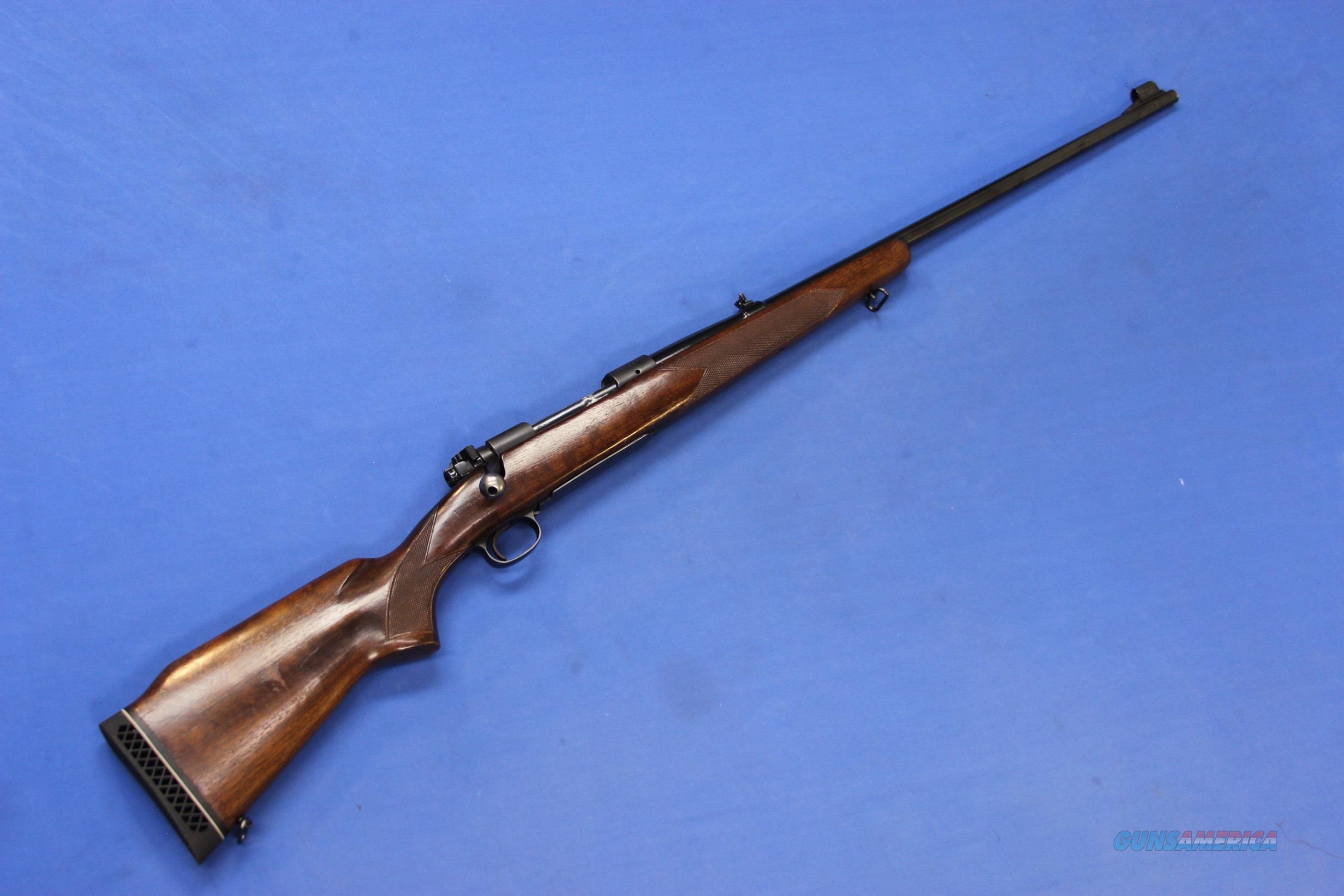
Wildcats
NO NOT THIS! As this is not a cute Kitty Blog!
As a side bar and at the risk of losing readers. I hate Cats!
No what I am talking about this the subjects of Wildcat Cartridges. So let us dig in and get going on to this subject!
Now when I was growing up in the Old Days. All real Americans were tinkerers of some sort. Always looking to improve things. So it was with the Gun Folks.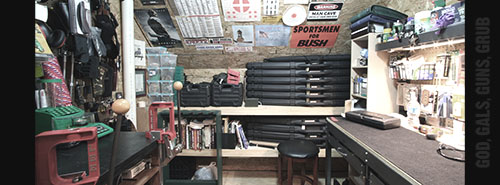
The big thing was to make a round go faster or what not. Usually of course most of these rounds never really took off.
So now a days you will see on the racks of Gun shops with the odd & sod gun with one really real weird one of a kind round.
Usually the inventor / owner having gone to their reward. (I.E. Died & the family wants the money)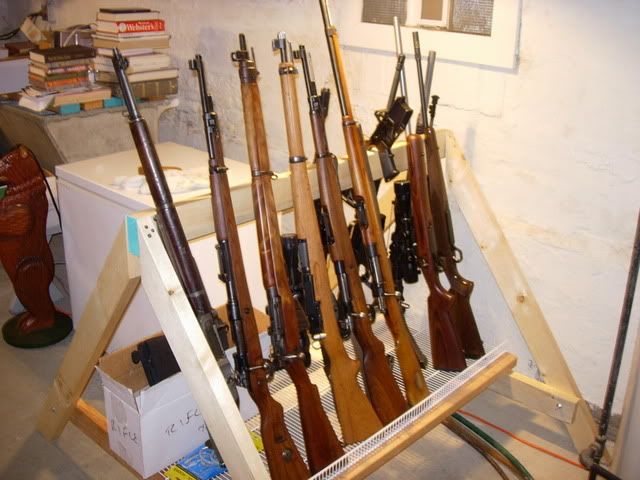
But on the up side. This is how we got some really great round too. Like the 22 Hornet, 25-06, 257 Roberts or the 35 Whelen.
So like life itself, It’s a mixed bag of the good, bad and the so-so. Here is some more information about this odd annex of the story of things that go boom.
Wildcat cartridge

.243 Winchester Ackley Improved(left) and .243 Winchester (right)
A wildcat cartridge, often shortened to wildcat, is a custom cartridge for which ammunition and/or firearms are not mass-produced.
These cartridges are often created in order to optimize a certain performance characteristic (such as the power, size or efficiency) of an existing commercial cartridge.
Developing and using wildcat cartridges does not generally serve a purpose in military or law enforcement; it is more a hobby for serious shooting, hunting, gunsmithing and handloading enthusiasts, particularly in the United States.[1]
There are potentially endless amounts of different kinds of wildcat cartridges: one source of gunsmithing equipment has a library of over 6,000 different wildcat cartridges for which they produce equipment such as chamber reamers.[2]
Contents
Development of a wildcat
Often, wildcats are commercially sold rounds that have been modified in some way to alter the cartridge’s performance. Barrels for the caliber are originally manufactured by gunsmiths specializing in barrel making.
Generally the same makers also offer reloading dies, tools to custom-load bullets into cases.
Because changing the barrel of a gun to accommodate custom cartridges requires precision equipment, most wildcats are developed by or in association with custom barrel makers.
Ammunition is handloaded, using modified parent cases and the gunsmith-provided wildcat dies. Generally the supplier of the barrel or dies will also provide the buyer with basic reloading data, giving a variety of powders, charge weights, and bullet weights that can be used for developing loads.
Handloaders use the data to develop a load by starting with minimum loads and carefully working up.
Wildcat cases and cartridges can be found for sale, but only from small makers.
Larger manufacturers usually do not produce wildcats because there is such a limited market for them and because there are no established CIP(Commission Internationale Permanente Pour L’Epreuve Des Armes A Feu Portatives – Permanent International Commission for the Proof of Small Arms) or SAAMI standards, which causes liability concerns.
Wildcat goals and methods
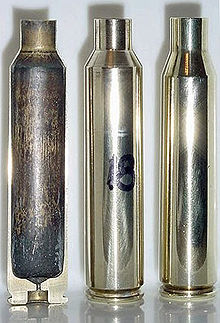
From left to right: cross sectioned and normal .338 Yogi wildcat cartridge cases compared to a factory .338 Lapua Magnum case.
Wildcat cartridges are developed for many reasons. Generally, the goal is to optimize some characteristic of a commercial cartridge in a given context.
Higher velocities, greater energy, better efficiency, greater consistency (which yields greater precision) and complying to a minimal permitted caliber or bullet weight for the legal hunting of certain species of game in a particular jurisdiction are the top reasons.
The sport of metallic silhouette shooting, has given rise to a great number of wildcats, as several rifle rounds are adapted to fire from a handgun.[3]
In using auto pistols for hunting or competitive shooting, improved feeding of soft nosed or hollow point bullets is also an issue; the bottlenecked .45/38, for instance, was created because the straight-cased .45 ACP had trouble feeding hollowpoints.[4]
Wildcat cartridges are generally developed because:
- Higher velocities can be obtained by increasing the case capacity, or reducing the caliber.
- Greater energy can be attained by increasing the caliber or the case capacity.
- Better efficiency can be achieved by increasing the shoulder angle, shortening the case, and reducing case taper (see internal ballistics).
- Greater consistency can be achieved by tuning the case capacity to a certain bullet diameter, weight, and velocity that give consistent results.
- Feeding problems can be fixed.
Some methods used to develop a wildcat are:
- Cold forming. The parent case is well lubricated and forced carefully into the reloading die for the wildcat caliber. This will swage the case into the new shape. This type of operation is used for reducing case dimensions, such as reducing the neck diameter or pushing the shoulder back, or changing the neck diameter.
- Fire forming. This consists of taking the parent case, or a partially cold formed case, loading it with a light bullet and light load of powder, and firing it in the firearm it will be used in. Another technique uses a charge of fast burning powder topped with a case full of Cream of Wheat and a wad, to form a special blank cartridge that will expand the case. This technique is used for increasing case dimensions, such as pushing the neck forward, increasing the neck angle, or straightening the case walls.[5]
- Trimming to length. Generally, after either a cold forming or a fire forming operation, the mouth of the case will be longer than ideal, and the case will be trimmed back to the “trim to” length. Trimming is a normal reloading operation, as high pressure cartridges will flow each time they are fired, and periodically need trimming to remove the brass that flows to the mouth.
- Changing the diameter of the case (to suit a new caliber). Called “necking up” or “necking down”, this is the most common way of making a wildcat. The new caliber allows a much different range of bullet weights, and can greatly increase the velocity or the power or the resistance to wind drift as compared to the parent cartridge.
- Necking back. This is a cold forming operation in which the neck is pushed back to reduce case capacity. This is often done when developing rounds for shorter barrels, such as turning a rifle cartridge into a handgun cartridge.
- Blowing out. This is a fire forming operation that moves the shoulder forward to increase case capacity.
- Changing the shoulder angle. By making the shoulder closer to square, the resulting space is closer to the ideal spherical shape, resulting in a more efficient burn. If the shoulder is also to be moved back, this is a cold forming operation; if the shoulder is to stay or be moved forward, it is a hot forming operation.
- Reducing the case taper. This hot forming operation makes the cartridge more cylindrical, giving similar results to a shoulder angle change.
- Changing the rim. While this is a wildcatting operation, it is generally only done by commercial operations, due to the precision turning needed. Generally this is a conversion from rimmed to rimless cartridge, or from rimless to rebated, and is done to allow a larger parent case than the firearm action was designed for. The opposite operation, adding a rim to a case, is also generally only done by major manufacturers; examples are the .45 Auto Rim, a rimmed .45 ACP allowing ejection in .45 revolvers without the use of moon clips, and the .307 Winchester, a rimmed .308 Winchester, developed for use in lever-action rifles. A handloader can add a rim, by swaging a ring of metal onto a rimless case, then turning it down, but this is very labor-intensive process and requires a special swaging die and precision metalworking lathe.[6] It is far easier for most handloaders to simply start with a rimmed case, either of the desired diameter or reamed out as desired.
- Increasing the case length. This process (which allows the cartridge to contain more propellant and thus increases potential energy of the bullet) was used to make the powerful .357 Magnum cartridge from the much weaker .38 Special: A .357 magnum bullet has more than 3 times more energy than a .38 special bullet of the same weight. Increasing the length of a bullet’s case usually involves getting rid of the old case and making a completely new one from scratch, which all but limits the feasibility of this kind of modification to commercial manufactures. It is possible to draw an existing case into a slightly longer form, thinning and stretching the existing case, but this is an operation requiring special equipment and expertise.[6] It is far easier and more common to reduce, not extend the length of a case.
Example wildcat cartridges
In terms of sheer numbers of varieties, there are more wildcat cartridges than there are production cartridges.
Most wildcats are custom made, and therefore are not generally well-known. Some wildcat cartridges, however, are produced commercially in small quantities by small manufacturers. This is a list of some representative wildcats.
- .30 Herrett. Based on the .30-30 Winchester, necked back and with a sharper shoulder angle. Developed for use in pistols with barrels as short as 10 inches (25 cm), it develops the same power as a .30-30 with greater efficiency and less muzzle blast.[7]
- .357 Herrett. Like the earlier .30 Herrett, this cartridge is based on the .30-30 Winchester, shortened and necked up to .357 (9 mm). Designed for use in short barrels, the resulting cartridge is more efficient and more powerful than the .30-30. Often considered one of the best medium game hunting calibers available in the 10″ (25 cm) barrelled Thompson Center Arms Contender pistol.[8][9]
- .10 Eichelberger Long Rifle. This is one of a smaller number of wildcats based on rimfire cartridges. It is made by disassembling a .22 Long Rifle cartridge, and re-using the case. The .10 caliber (2.5 mm) is the smallest rifled barrel made. The tiny .10 caliber bullets produce almost no recoil and travel at very high velocities. While it can be used on small game at short ranges, this cartridge is more of a curiosity than a practical hunting or target round.[10]
- 5.7 MMJ, or 5.7mm Spitfire. A .30 Carbine case necked down to .223 caliber (5.56 mm), this cartridge was developed to convert military surplus M1 Carbines into short range varmint guns.[8]
- 6mm PPC. Based on the .220 Russian, which is in turn based on the 7.62×39mm intermediate-power cartridge. The 6mm PPC was developed in 1975 specifically for benchrest shooting. While it is anything but common anywhere else, the 6mm PPC unseated the .222 Remington from its 20-year spot as the best benchrest cartridge available. Chambered only in single-shot rifles due to its short, fat case and sharp shoulder angle, the 6mm PPC is still going strong in benchrest after 30 years.
- .22 Eargesplitten Loudenboomer. This humorously named cartridge was developed by P. O. Ackley specifically to exceed 5,000 ft/s (1,500 m/s) muzzle velocity. Based on a .378 Weatherby Magnum case, the case is impractically overpowered for the bore diameter, and so the cartridge remains a curiosity.[11][12]
- 7 mm TCU (also known as 7TCU). Based on the .223 Remington case, the 7 mm TCU is popular in single-shot handguns such as the Thompson Center Arms’ Contender and G2 Contender. It is but one of a family of wildcat TCU cartridges.
Wildcat cartridges in Australia
In Australia, wildcat cartridges were relatively common.]
Most are made primarily for hunting species such as deer, kangaroo, are generally based on the .303 British because of the post war popularity of that round and of the cheap surplus Australian Lee–Enfield MkIII military rifles available.
Many of these surplus rifles were rebarreled to .257 caliber, known as the 303-25.
One of the unique features is that these cartridges relied less on handloading – and instead were offered as proprietary cartridges from gunsmiths.
Since having an existing barrel rebored and rechambered was (at that time) less expensive than fitting a new barrel, a 303-25 rifle with a shotout barrel could be economically converted to .277 caliber, known as the 303-270.
The .222 Remington – a .222 Rimmed in a Martini was also commonly found. As too were the “Tini-Mite” and “Mini-Mite” cartridges, .17 caliber rimfire cartridges based on the .22 Long Rifle case.[2]
Commercially accepted wildcats
Some cartridges started out as custom-made (non-commercially developed) wildcats, and gained wide enough acceptance or popularity to become commercial cartridges.
Generally, cartridges become popular commercially after a commercial firearms maker begins offering a weapon chambered in the cartridge.
Once popular enough, funding is generated for SAAMI standards development. After SAAMI standards are in place, any firearms or ammunition maker can be sure that any products manufactured to the SAAMI standards can be safely used.
Some examples of custom cartridges that became commercially accepted are:
- .22-250. Based on a .250 Savage case, the .22-250 is still one of the fastest shooting .22 caliber (5.56 mm) cartridges available. First offered in a factory firearm by Browning in 1963 (the first factory gun chambered for a wildcat), the .22-250 was later adopted by Remington as the .22-250 Remington.[13][14]
- .22 CHeetah. A .308 BR (Bench Rest) case necked down to .22 caliber, the .22 CHeetah provides a flat trajectory with a .22 caliber bullet that has a relatively high speed of 4,000 ft/s. Hard on barrels, it provides a very effective 300 yard varmint round.[15]
- .303/25. A .303 British cartridge necked down to fire a .25 calibre projectile, developed in Australia during the 1940s as a Kangaroo culling and pest control round. Popularised in the late 1940s and 1950s in New South Wales, owing to restrictions in that state on ownership of .303 British calibre firearm and the difficulties of obtaining commercial hunting arms and ammunition from overseas. Now largely obsolete, but there are still large numbers of converted Lee–Enfield rifles chambered for this round in Australia.[8]
- 6.8 mm SPC. This cartridge was developed by American military special operations soldiers in search of a more lethal round than the 5.56×45mm NATO. It is based on the .30 Remington cartridge necked down to .270 caliber, and sized to fit in the M16 rifle. The 6.8 SPC is currently deemed unlikely for official military adoption, but is fielded by special operations troops in Afghanistan and Iraq and is gaining popularity as a commercial round.[14]
- 7 mm-08. A .308 Winchester necked down to 7 mm (.284 caliber), the 7 mm-08 provides a flatter trajectory with lighter, more aerodynamic 7 mm bullets. It provides nearly the performance of a 7 mm Magnum, but can use a shorter rifle action and does not need a belted case.[14]
- 7-30 Waters. Designed to improve the performance of lever-action rifle designs dating back to the 1890s, the 7-30 Waters is a .30-30 Winchester necked down to 7 mm (.284 caliber). Even with the lower chamber pressures allowed by the lever-action rifle and the flat tipped bullets necessitated by the tubular magazines, the 7-30 Waters offers a significant gain in velocity and sectional density with little loss in bullet weight. This cartridge has also developed a following among handgun hunters using single-shots such as the T/C Contender or G2, which can take advantage of spitzer (pointed) bullets that are unsafe in tubular magazines. It is very efficient on small to medium-sized game including whitetails and mule deer.[14]
- .454 Casull. This magnum revolver cartridge, a lengthened .45 Colt, was developed by Dick Casull and Jack Fulmer in 1957 as a high-powered big game hunting round. For many years, the small Wyoming manufacturer Freedom Arms was the only substantial maker of guns for the cartridge. In the mid-1990s, two major manufacturers, Ruger and Taurus, started selling guns chambered in .454 Casull because it was popular due to its extreme power. It was finally commercialized in 1998, when SAAMI published its first standards for the cartridge.[16][17]
Commercially developed wildcats
Though a cartridge technically has to not be developed commercially to be considered a wildcat, some commercial cartridges were developed by ammunition and firearm manufacturers by modifying existing cartridges – using essentially the same process used to make wildcats.
Cartridges that are modified by being made longer (usually to make them more powerful) are for the most part only created commercially because of the difficulty of the process.
One example of such a cartridge is the .357 Magnum, which was developed from the .38 Special in 1934 by firearms manufacturer Smith & Wesson.
- .38-40. One of the oldest wildcats, the .38-40, introduced by Winchester Repeating Arms Company in 1874, was made by necking down a .44-40. Actually a .401 in (10.2 mm)[18] cartridge, the .38-40 had faded into obsolescence before being revived with the growing popularity of Cowboy action shooting. The ballistics of the .38-40 are close to those of the .40 S&W.[19]
- .221 Fireball. This cartridge was developed by Remington Arms for the XP-100 pistol, which was a single shot bolt action pistol. The .221 Fireball was a necked back .222 Remington, designed for greater efficiency in the 10 in (25 cm) barrel of the XP-100. Even loaded with a smaller load of faster powder for the short barrel, the .221 Fireball lived up to its name, with a massive muzzle flash; the performance, however, was unheard of for its day: over 2700 feet per second (885 m/s) out of the short XP-100 barrel. It remains the fastest SAAMI approved handgun cartridge, and the cartridge is so efficient and accurate that it has been chambered in rifles as well.
- .22 Remington Jet. This cartridge was developed by Remington for a Smith & Wesson Model 53 revolver and a Marlin Model 62 lever-action rifle, but the rifle was never produced in this calibre. The .22 Remington Jet was a necked down .357 Magnum case.[20] The .22 Jet is no longer manufactured by Remington or other commercial manufacturers.
- .357 SIG. This now-popular pistol cartridge was developed by Swiss weapons company Sig Sauer in an attempt to produce ballistics matching the powerful .357 Magnum revolver load, but in a semi-automatic pistol cartridge. The cartridge was made by necking down and slightly stretching the .40 S&W case, which itself derived from the 10mm Auto.
- .400 Corbon. This cartridge was designed to produce 10mm Auto ballistics in a cartridge that could be chambered in a .45 ACP pistol with a simple barrel swap. It was made by necking a .45 ACP down to .40 (10 mm). Initially, no firearms were available in .400 Cor-Bon, but barrels in the new caliber were produced for the M1911 pistol.
- .41 Action Express. Developed in 1986 by Action Arms for the Jericho 941 pistol. It, like the .357 SIG, attempted to make a magnum-power cartridge for a semi-automatic pistol. It started with a .41 Magnum case and cut it down to fit in a semi-automatic pistol chambered for 9×19mm. The rim was then turned down to the same dimensions as the 9×19mm, making it a rebated rim cartridge. This allowed a unique switch up to a larger caliber. The .41 AE never saw huge commercial success because of the creation of the similarly-powerful .40 S&W in 1990.[21]
- .204 Ruger. Introduced in 2004 by Ruger, in its time it held the title of fastest production cartridge with a velocity of 4225 ft/s (1290 m/s) with a 32-grain (2.1 g), .204 bullet from a 24-inch (610 mm) barrel. Intended as a varmint riflecartridge, the .204 was based on the .222 Remington Magnum, which is slightly longer than the .223 Remington and offers about 5% more case capacity. Designed to have a very long point blank range, the factory loading offers impressive ballistics, 1.5 inches high at 150 yards (140 m), and 1.5 inches (38 mm) low at 277 yards (253 m).[citation needed]
Second (and later) generation wildcats
Some wildcats are based not on commercial rounds, but on other successful wildcats. The .308 × 1.5″ Barnes, a wildcat from noted cartridge author Frank Barnes made by simply necking a .308 Winchester back to 1.5 inches (38 mm) in length (38.1 mm) is probably the best example of a wildcat that has spawned many other successful wildcats.
The .308 x 1.5″ case is available from a number of case manufacturers, and differs from a homemade .308 x 1.5″ in that it has a small primer pocket, where the original .308 Winchester case has a larger primer pocket (the smaller primer is more suited to the smaller case capacity of the short round).
There are at least 8 wildcats that are made from the small primer .308 x 1.5″ brass, including some very successful benchrest rounds, including the Benchrest Remington family of cartridges, .22 BR, 6mm BR, 6.5mm BR, 7mm BR, .30 BR.
Another example is the .220 Russian, based on the 7.62×39mm. Since nearly all 7.62×39mm ammunition made in the 1970s used the complex-to-reload Berdan priming, and often steel cases, it made a poor choice for wildcatting.
The .220 Russian, however, was and still is readily available in Boxer-primed, brass cases of high quality. The .220 Russian is still the parent cartridge of choice for the PPC line of cartridges, such as the .22 PPC and 6mm PPC, even though there are far more PPC chambered firearms available than .220 Russian chamberings.
Likewise, the PPC line of cartridges were the parent case of the 6.5 Grendel, a long-range, high-energy cartridge for the AR-15.[22]
See also
- Whisper (cartridge family), proprietary cartridges by J. D. Jones
- Wildcats for Special Applications
- .30-06 Springfield Wildcat Cartridges
References
- Jump up^ “Guns per Capita in the US”. Reuters. 2007-08-28. Retrieved 2009-03-03.
- ^ Jump up to:a b Frank C. Barnes. Stan Skinner, ed. Cartridges of the World, 10th Ed. Krause Publications. ISBN 0-87349-605-1.
- Jump up^ Robinson, John. “Wildcats”. Sporting Shooters’ Association of Australia. Retrieved 1 October 2010.
- Jump up^ Barnes, Frank C. Cartridges of the World (Northfield, Illinois: DBI, 19776), p. 140, “.45-38 Auto Pistol”.
- Jump up^ Case-Forming Top Contender Hunting Loads, Performance Shooter, May 1997; includes information on cold forming and fire forming, including the “Cream of Wheat” fire forming method.
- ^ Jump up to:a b Nonte, Jr., George C. (1978). Basic Handloading. USA: Times Mirror Magazines, Inc. LCCN 77-26482.
- Jump up^ “.30 Herrett”. Archived from the original on 2007-11-01. Retrieved 2007-11-14.[self-published source]
- ^ Jump up to:a b c “Wildcat Cartridges”. Retrieved 2007-11-14.[self-published source]
- Jump up^ “.357 Herrett”. Archived from the original on 2007-11-01. Retrieved 2007-11-14.[self-published source]
- Jump up^ AmmoGuide.com, free registration may be required.
- Jump up^ “.22 Eargesplitten Loudenboomer”. RelaodersNest.com.
- Jump up^ Ackley, P.O. (1927) [1962]. Handbook for Shooters & Reloaders. vol I (12th Printing ed.). Salt Lake City, Utah: Plaza Publishing. p. 442. ISBN 978-99929-4-881-1.
- Jump up^ “The Great .22-250”. Rifle Shooter Magazine. Retrieved 2007-11-14.
- ^ Jump up to:a b c d “Rifle Cartridges”. Retrieved 2007-11-14.
- Jump up^ Cartridges of the World p. 188.
- Jump up^ Chuck Hawks. “.454 Casull”. Retrieved 2007-11-14.
- Jump up^ “.454 Casull”. Retrieved 2007-11-14.
- Jump up^ Barnes, Frank C., ed. by John T. Amber. Cartridges of the World (Northfield, Illinois: DBI Books, 1972), p.67.
- Jump up^ John Taffin. “TAFFIN TESTS: THE .38-40 (.38WCF)”. Retrieved 2007-11-14.
- Jump up^ Barnes, Frank C., ed. by John T. Amber. Cartridges of the World (Northfield, Illinois: DBI Books, 1972), p.148, “.22 Remington Jet”.
- Jump up^ “Pistol Cartridges”. Retrieved 2007-11-14.
- Jump up^ Chuck Hawks. “The 6 mm PPC-USA”. Retrieved 2007-11-14.
External links
- The Wild Cat: An Endangered Species? Guns magazine, Dec 2000 by Charles E. Petty
- Loading Wildcat Cartridges: a Few Simple Considerations Make Life Much Easier Guns magazine, August 2005 by Charles E. Petty
- Wildcat Cartridges wildcat cartridge descriptions at The Reload Bench
- Reloading Techniques: .22 Win. Magnum Rimfire, Performance Shooter, April 1996
- What is a Wildcat? A gunsmith’s description of Wildcat Cartridges.
A Primer On Deer Hunting
| November 4, 2014
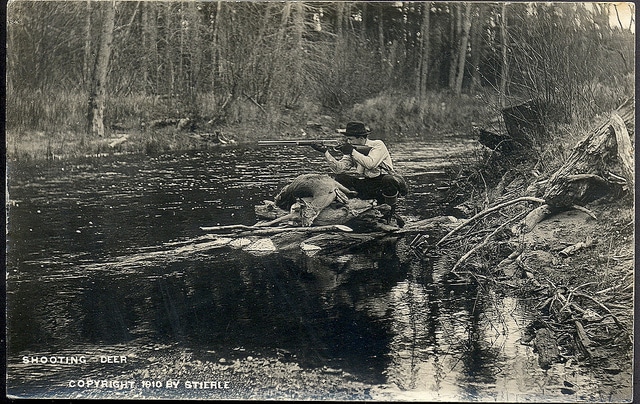
Editor’s note: This is a guest post from Josh Cantrell and Kevin King.
The hunting of various species of wild deer has been a national passion and tradition for countless generations. Many Native American stories and accounts are riddled with the hunting and harvesting of whitetails. The Pilgrims of Plymouth Plantation, in addition to numerous waterfowl and turkeys, harvested deer or “venison,” as was documented by William Bradford in his journals. Many early explorers of the West found whitetail and mule deer to be a bountiful, necessary food source for themselves and their families. Unfortunately, the 20th century saw a sharp decline in the harvesting of deer due to overhunting and a decreasing population of whitetail throughout the United States. However, due to the diligent efforts of state conservation departments and responsible hunters, many states now boast close to 200,000 or more harvested deer each year. In fact, in many states deer are overpopulated and are threatening forest growth and farms and may also increase the risk of lyme disease in humans in areas where their numbers are particularly high. Responsible hunters play an important role in managing deer populations so the herds don’t stress ecosystems.
Your may have found yourself considering deer hunting at one time or another but never really knew where to start. The advantages of deer hunting are numerous:
- Fresh, organic, lean meat
- Time spent in nature
- Cultivated survival/outdoorsman skills
- Personal growth as a man/provider
- Character development
- Marksmanship
- Tradition
With this primer on deer hunting, and some practice and mentoring from experienced hunters, you should be able to take to the woods with confidence in pursuit of your first in a long and happy series of deer.
Choose Your Weapon

The first place to start with deer hunting is to decide your method. Do you want to be a rifle hunter or do you want to be an alternative methods hunter (bow, atlatl, pistol, etc.)? Many of us began as rifle hunters because it is the most accessible place to start. Since this is a beginner’s primer on deer hunting, we would recommend starting with a rifle and then branching out as your interests dictate.
When choosing a deer rifle, one must take budget and fit into account. When I recently spoke to Ken Jorgensen at Ruger Firearms he recommended that a hunter finds a rifle that:
- Completes the task effectively (in this case, kill a deer quickly)
- Fits the shooter
- Can be shot well
It is worth your time and efforts to go to a gun store and “try out” potential rifles. Pick up the guns, shoulder them, manipulate the actions, sight-in an object on the floor or ceiling, and just see how you like them. A few models of guns to look into as a budget-friendly starting point are:
- Winchester Model 70
- Savage Trophy Hunter XP
- Weatherby Vanguard
- Remington Model 700
- Ruger American Rifle
To complete the task effectively in deer hunting requires a cartridge with a little punch. However, if you are unfamiliar with gun calibers, choosing the best caliber for yourself is like choosing some random battery off the shelf and hoping that it will work in your TV remote. You need the proper amount of power combined with your ability to manage recoil. A few common calibers for deer hunting are as follows:
- .270 Winchester
- .308 Winchester
- .30-30 Winchester
- .30-06 Springfield
- 7mm Remington Magnum
All of these calibers are favorites amongst deer hunters and outdoorsmen. If you can, try to shoot these calibers before you buy one to see which you like; each cartridge almost seems to have its own personality. If you cannot shoot before committing to a rifle, read and watch as many reviews as possible to educate yourself on their uses. If you choose an adequate caliber and the gun fits you well, you have won 2/3 of the battle. All you have to do now is practice.
A great place to start when practicing is to shoot from a bench towards a stationary target, placed at 25 yards. You want to work on placing groups on the target that are all striking near the same position. Then, as you get more familiar with the gun, move your target out to 100 yards and work on the same thing. A 100-yard shot is a good place to begin as a first-time hunter. As you get more familiar with the gun, you will be able to work out to farther shot placements. However, for your first, 100 yards is a respectable distance.
Hunter’s Safety Course
Once you have acquired the gun and skills required to hunt efficiently, there is one final step of the process: becoming certified and licensed by your state conservation department. Regulations on becoming licensed vary from state to state. Most states require anyone who wishes to legally hunt with a firearm to take a hunter’s safety course. The requirements of the course, including the age at which one must be licensed, varies from state to state. The best source for this information would be your state conservation department website or a nearby conservation office.
Most hunter safety courses include a 4-hour course and a written exam. You can study for the exam online or with an instruction booklet provided by your conservation department. Then, once you have prepared for the class, simply register for your 4-hour certification course online or in person. Most of these classes are free of charge. Once you have passed your test and received certification, you are now able to purchase your permits for your hunt.
If you are not sure yet if deer hunting is for you, you might look into a short-term alternative to acquire your hunter permits. In many states, there are hunter apprentice programs that allow you to take to the field alongside another certified hunter that has completed their hunter’s safety course. This allows you to buy permits and hunt in this manner for a brief time before you take a hunter’s safety course for yourself. That way, you can decide if it is a good fit for you.
Before taking to the field, it is important to read your state’s hunting regulations thoroughly each and every year that you hunt. These regulations, due to management needs, can change annually.
Dressing for the Field
The next step is to outfit yourself with hunting gear. This is where a hunter can really lose themselves in the influx of scents, camos, and various other products that supposedly offer unlimited success. Here are the bare-bones necessities when you head into the woods on your hunt:
- Your gun
- Blaze orange hat and vest (wear this 100% of the time – it can save your life)
- A box of ammunition (unless you shoot and miss a lot, this should suffice)
- A good, sharp knife (for field dressing your deer)
- Tall rubber gloves (for field dressing your deer)
- A flashlight (for tracking your deer)
- Warm gloves, hat, and jacket (for those cold November hunts)
- Your permits (the most essential item)
- A ziplock bag, zip tie, and a pen (depending on your state laws for tagging your game)
Finding a Place to Hunt

Once you have procured all of your essentials and are now a proficient marksman, the next step is finding a place to hunt. If you are a landowner with enough land to hunt, you are in luck. If not, you need to either find some public hunting land in your area or become friends with some of your local farmers and landowners. Never hunt somewhere that you have not obtained permission to hunt. Build a good relationship with those kind enough to let you hunt and, if you are blessed with a harvest, share a portion of it with your host.
When you find land, either choose a location in a wooded area that allows for deer and other animals to pass by, or choose to hunt the edge of an open field. This is where pre-season scouting becomes very important. When hunting for the first time, we recommend hunting from ground level, but if you prefer a stand, make sure you choose one that is stable and easy to climb into with a rifle and your gear. These types of stands are called tripod stands and can be found at your local outdoor stores. These stands increase the cost of your hunt dramatically, so decide whether a stand is necessary before making the investment. The advantage to hunting out of a stand is that you are not eye level with the deer so it is harder for them to see you.
You want to make sure that your stand or ground location is along a path that deer travel frequently. Another thing that you should consider when picking your stand or hunting spot is your comfort level. If you are not able to consistently make long shots, an open field is not the place for you. You should try setting up in some hardwoods where the only shot that you can take is a close one. Make sure you arrive to your hunting location before sunrise or a few hours before sunset, so as to minimize your presence. Then, patiently wait for your game to arrive.
One way to increase the odds in your favor is to put out a salt lick, a food plot, or other attractants near your hunting spot before the season opens. These attract deer, as well as other wildlife, and make your hunting location part of their regular routine. One thing to consider when doing this, however, is the potential requirement to discontinue your attractants before the season (normally 10 days prior). Otherwise, you may be dealing with a baiting violation and a huge fine. If you take this step, be aware of all of the responsibilities involved and take the necessary precautions to ensure an ethical, legal hunt. Every state is different, so check your state’s laws about food plots and baiting. When trying to decide what would work best for you, think through your hunting situation and commitment level. It takes time, land, and discipline to plant and maintain a plot. Make sure that you are ready to make that commitment of both time and resources.
Taking the Shot
When taking a shot, you always need to wait for a deer to stand broadside, which means that they are standing perpendicular to your rifle barrel. When you can see from nose to tail, bring your sights onto the deer just behind the front shoulder, as you want to hit the lungs and/or heart. Quietly take the gun off safety, take a big breath and let it out, and evenly squeeze the trigger until the gun fires. Immediately, rack the bolt and chamber a live shell.
If you have hit your mark, watch where the deer takes off. Wait anywhere between 15 and 30 minutes before tracking and pursuing. This will give the deer plenty of time to lie down and expire. If you try to chase the deer as soon as it is shot, you are going to place unneeded stress on the animal. This will also cause more adrenaline to be produced by the deer, which will make it travel farther. The additional surge of hormones and chemicals can potentially result in your venison developing a strong “gamey” or undesirable flavor. If the deer has crossed a property line, make sure that you have permission to be on that property before pursuing. It is still considered trespassing if you are chasing a wounded animal. Make sure you know who owns all of the land around you and how to get in touch with them. It’s your responsibility to make every effort to recover any deer you shoot.
Following the Trail
To track your deer, go to the location where you think your shot connected with the animal. When you reach that location, look for the tell-tale signs of a wounded animal: ground severely torn by hooves, tufts of hair, bone fragments, and most of all, blood. At this point, many hunters put down an object, such as a hat, next to the first hint of a trail. Do your best to look for a trail of any of these materials on the ground and follow it to find your deer. If the blood becomes more plentiful, you are on the right track. If, at any time, you lose the trail, go back to the last point where you had a clear trail and track it again. Taking a buddy or a group of other hunters to help track a difficult trail can be the difference between an animal harvested and an animal wasted. (You might also consider hunting with a canine companion.)
When you come upon your deer, do so with a loaded gun, ready to put your game down if it is not yet expired. Once you have determined that your animal is down, take a moment to pat yourself on the back and breathe a sigh of successful relief. After that, it’s time to get to work.
After the Shot
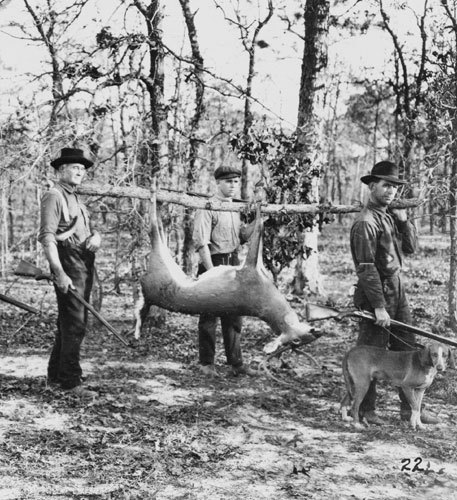
Before dressing your game, make sure you first tag your deer. Follow the methods of tagging your game that are required by your conservation department, to the letter. Some states have you attach the permit to an antler, others have you place it in a plastic bag around the leg, and others have you tag the animal via smartphone. Make sure you are familiar with and prepared for the tagging procedures before you are out in the field.
Methods for field dressing a whitetail are varied and everyone thinks that their way is the right way. Therefore, while there are a few “essentials” when dressing a deer, to get a more specific how-to, I recommend looking at videos online or reading the literature given out by state conservation organizations.
The standard way to field dress a whitetail begins with a long incision (blade facing up) between the pelvis and the sternum, making sure not to nick the internal organs. Remove exterior genitalia and discard before cutting in a circular motion around the anus. With a short length of string, tie off the lower intestines and bladder inside the body cavity before rolling the deer over on its side to empty the contents. Some cutting will be needed to free the organs from the back. Then, cut through the diaphragm (some people split the rib cage here, as well), remove the lungs, heart, and the windpipe as high as you can reach. Then, turn your deer over one more time to drain any remaining blood left in the cavity.
At this point, you can take your deer to a meat processor and they will work up the deer for a fee. However, if you want to work it up yourself, get the deer someplace where it can be hung upside down and drained out for a few hours before quartering and butchering it, much like you would a cow. If you are doing the self-butchering method, we also recommend getting a grinder, a group of people to help, and a lot of food-saver vacuum bags. Lastly, make sure you clear out a nice big spot in the freezer for all of the great meat you are going to enjoy for months to come.
Ethics in the Woods
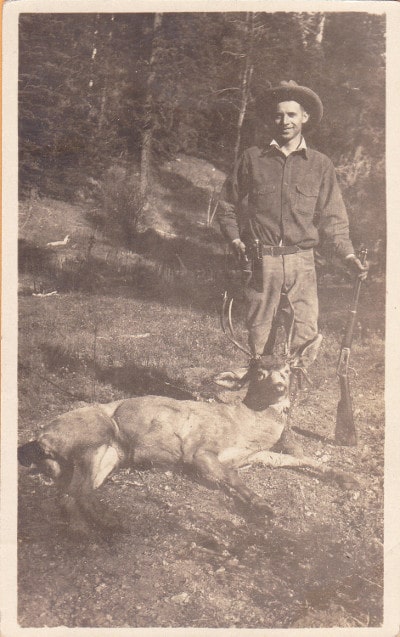
When going out in the woods in search of deer it is important that you maintain a high ethical standard of behavior. One of the best ways to do this is to practice with your weapon of choice. The more confident you are with your weapon, the more humane you will be to the deer.
Treat all the land with respect. Anything you pack in, make sure you pack it out. Unfortunately, there are hunters out there that are not interested in cleaning up after themselves. If you come upon trash (shell casings, food wrappers, discarded scents, etc.), pack out that trash as well, even though it is not your own. The more we all work to take care of our natural resources, the longer it will be there to enjoy. Make sure that safety is always at the forefront of your thinking when hunting, even if you are hunting alone. Accidents can happen when you are by yourself, so always be overly cautious and ensure that safety rules are being followed.
Lastly, don’t allow yourself to get too caught up in the technical aspects of the hunt that you forget to enjoy the experience. Deer hunting is a fun, challenging, exciting, and character-building way for you to feed your family while maintaining a tradition that spans far beyond the history of this nation and its inhabitants.
___________________________
Josh Cantrell and Kevin King are avid outdoorsmen, fishermen, hunters, and teachers in southwest Missouri.
- Wash your hands and then use
- the water for your next flush.

- Traffic lights in
- Ukraine

- This water fountain allows the water
- to flow down so dogs can
- drink too.
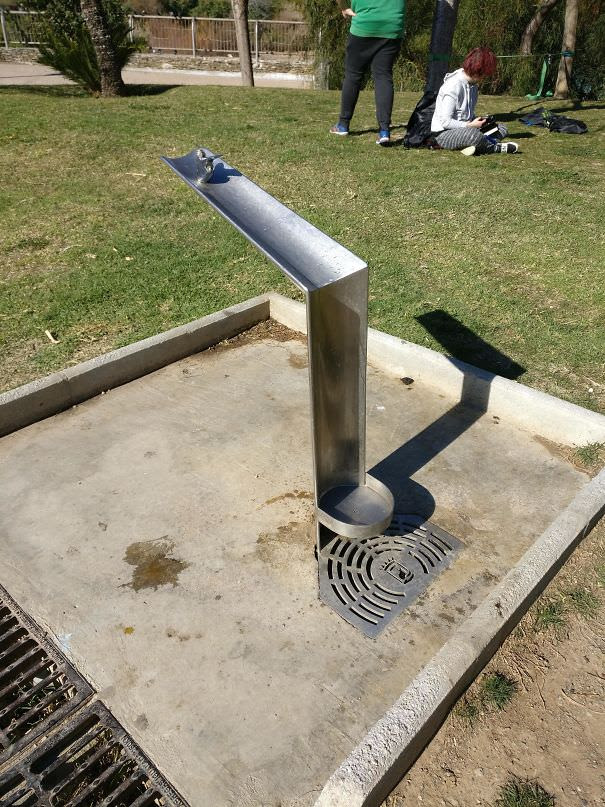
- An accessibility mat on the beach
- for strollers and wheelchairs.

- This pill bottle lid tells you when
- it was last opened.
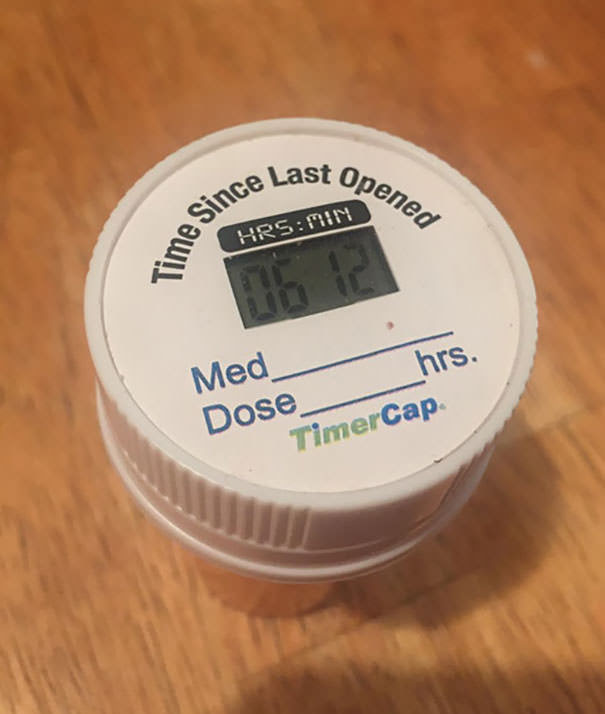
- Seniors and handicapped people can
- extend cross time for this 8
- lane highway.
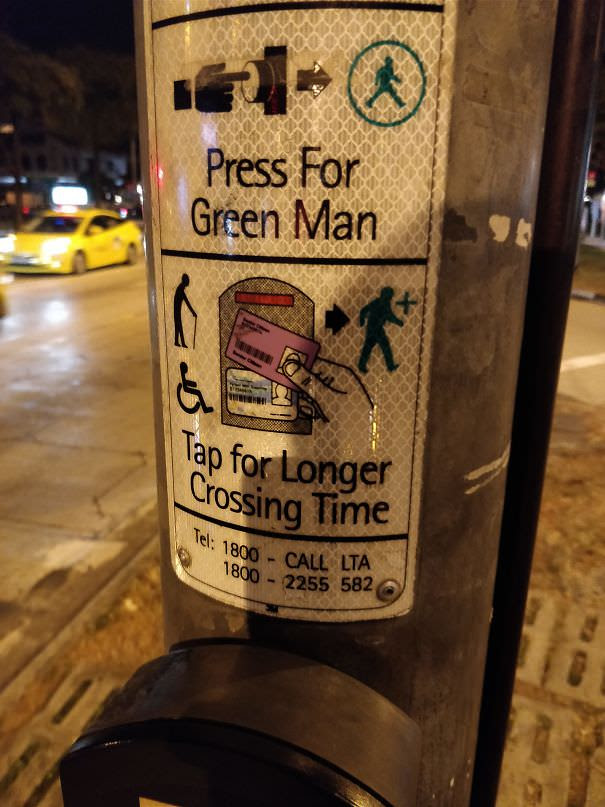
- This restaurant has a toe opener for
- those who want to avoid
- germs on the doorknob.
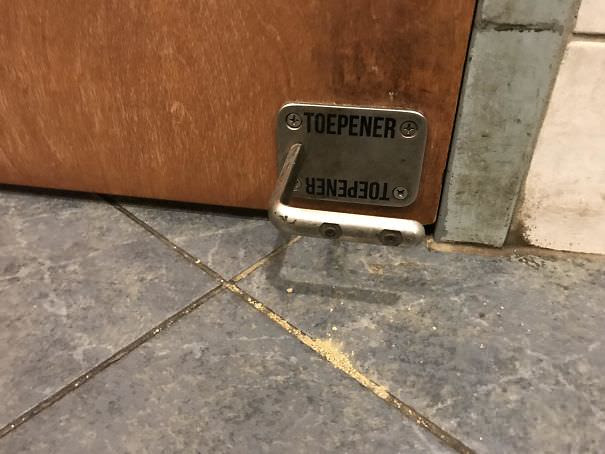
- This shopping cart has a calculator
- so you know how much you’re
- spending.

- This bar has a frost strip so you can
- keep your drink cold.
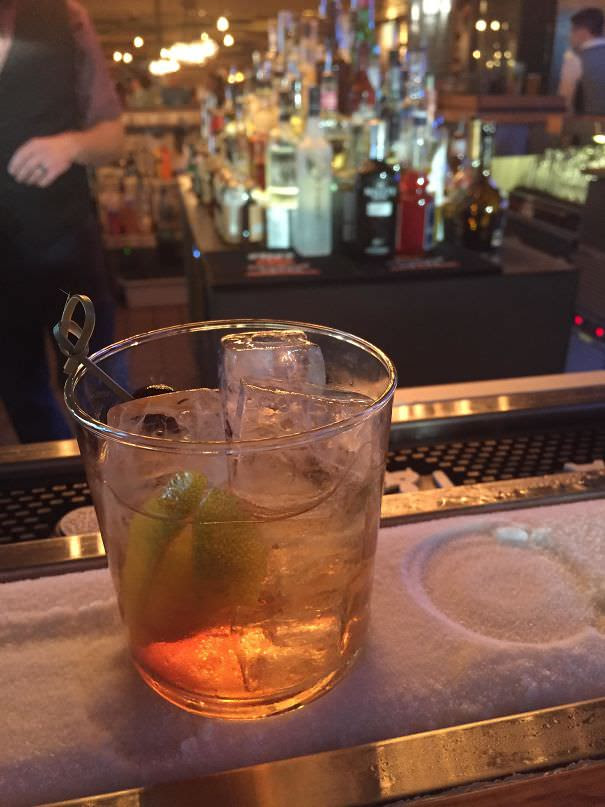
- This tire tells you when it’s time to change it.
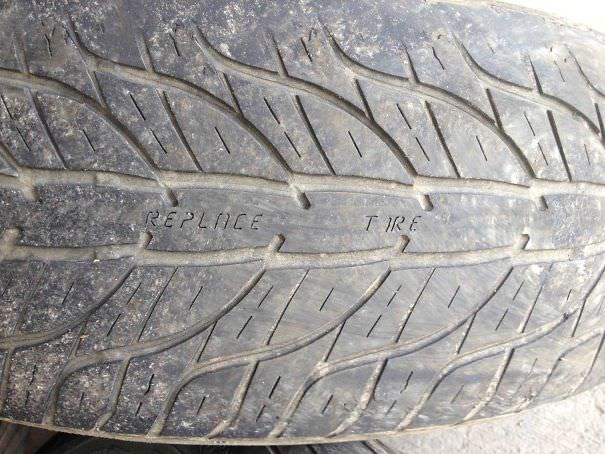
- This mirror has a heated part
- so it doesn’t steam up after a shower.
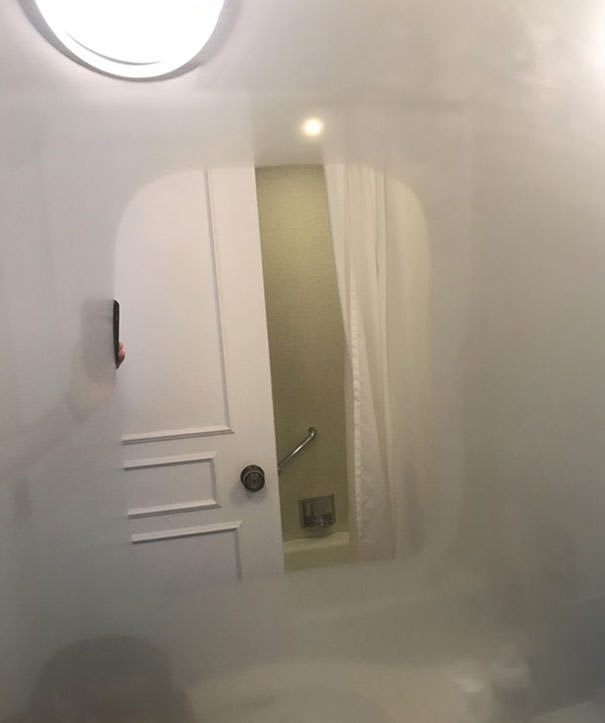
- These tiny model tents give you a
- look at what you’re buying .

- This elevator shows how close
- to capacity it is based on the
- weight of the riders.

- This inflatable mattress turns
- the back of your car into a bed .
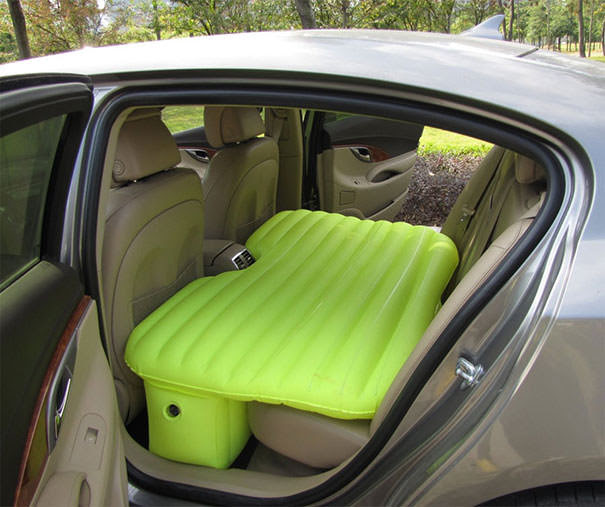
- ï Trash cans in Copenhagen
- are angled so that cyclists can
- throw their trash while cycling.

- Analytical Approach to Life. . .




